Somebody’s always throwing bricks…
Playing ugly Yahoo tricks.
Robert Arneson
Brick with Hand of
1991
modeled 1972
bronze
9 1/2 x 8 1/2 x 4 inches
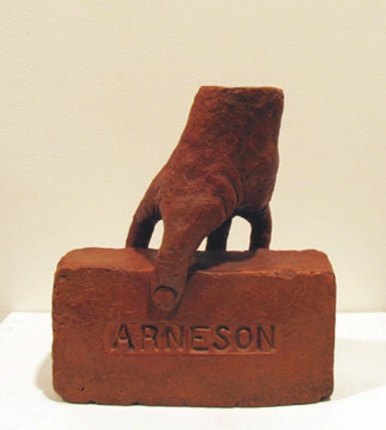
Before Robert Arneson achieved his signature style, he was so enamored by Peter Voulkos‘ corrosive clay that Arneson almost followed him from the Bay Area to L.A.
Instead, Arneson went North to teach at U.C. Davis, where the West Coast Funk dynasty took root and grew, partly inspired by Chicago’s Jim Nutt and Gladys Nilsson, key Hairy Who figures in briefly California, drawn by the prospect of a paying job (his).
Manhattan is not the first place one would be expect to see an excellent exhibit tracing the roots of Arneson’s journey, from boundary-pushing potter to Rabelaisian, high-style story-teller, but New York is where you find everything; including, creeping in along the edges, an acknowledgment of the West Coast beyond L.A.
For this museum-quality trip through Bay Area art history, 1956-66, N.Y. can thank the George Adams Gallery. It proves that instead of starting out as a second-class Voulkos, Arneson was always himself. Although both were equally committed to clay, Arneson loved the world’s cheap charm (and New York’s Pop) too much to be entirely comfortable in Voulkos’ high-minded clay version of Abstract Expressionism. While Voulkos tore into his slash and burn, Arneson’s achieved his own kind of comic and forlorn lumpiness, a version of Ab Ex unknown at the time but later explored to great effect by Philip Guston.
Arneson, Egg Pot
1959
glazed ceramic
10 1/2 x 11 3/4 x 7 3/4 inches

That pot eventually led to this glory: Pei-Pee
1964
glazed ceramic
9 x 19 3/4 x 14 inches.
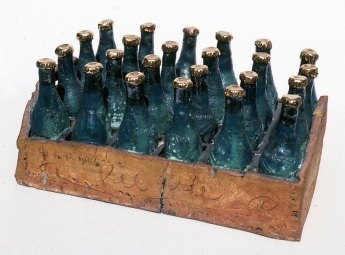
Also terrific:
Richard Tuttle (drawings and installation) at Sperone Westwater. This must be a no-hard-feelings show, as Tuttle left SW for Pace. Tuttle is the 21st Century’s Paul Klee. Nobody else who’s now alive can take a line for a walk with such understated power.
Barbara Kruger at Mary Boone. Three large video screens, cheap jokes in the Richard Prince vein taken in another direction, haunting, heartfelt and unlike Prince’s, genuinely funny.
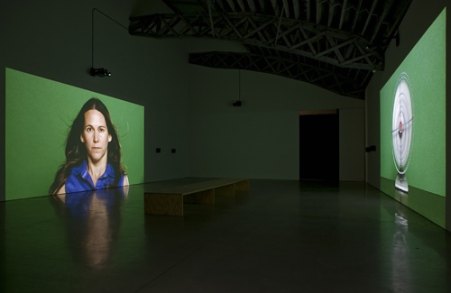
Glenn Rudolph at Bruce Silverstein, selected by Matthew Higgs.
Rudolph Cherry Picker 2002 Archival inkjet print 30 x 30 inches
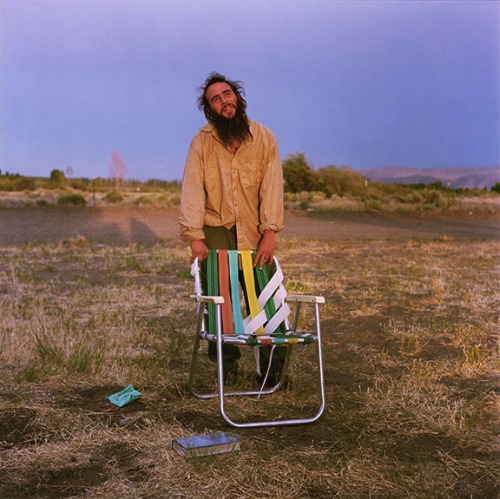
Nice to see Rudolph in New York, especially because, living in Seattle, he no longer has a Seattle gallery. I’d love to see Rudolph’s train photos paired with Justine Kurland’s from This Train Is Bound For Glory.
Higgs:
I first saw Glenn Rudolph’s work in 2003 in Portland, OR. I was living
in Oakland, CA, at the time and I’d been invited to Portland by the
artist Harrell Fletcher to give a talk. The talk was held in a gallery
space where Glenn’s work was on display. I’d never heard of Glenn or
seen any of his work. I’d no idea where he was from, how old he was or
what he’d done before. His work immediately made me think of other
artists’ work – all great art has this effect. Glenn seemed to have
absorbed the history of American photography and then distilled it into
something uniquely his own. His work is profoundly local. This is
important to acknowledge. Even though I knew nothing of the people and
places depicted in his images, Glenn’s evident empathy for his subjects
made them strangely familiar. This is hard to pull off and it’s not
something that can be taught.
Catherine Opie at Barbara Gladstone. Opie at her most voluptuous. New York poet Eileen Myles is in this show, rounding out her life in photography. Robert Mapplethorpe shot her in the 1970s. On hearing she was a poet, he advised her to put together a band. The Mapplethorpe hangs in her tiny apartment in the East Village, in a bathroom too small for a shower, never mind a tub. Really good poet, but poets who do not form bands (and do not get tenure) tend to live large only in their spacious minds.
Obviously not a poet:
Jenny (Bed), 2009 Chromogenic Print; (37 1/2 x 50 inches)
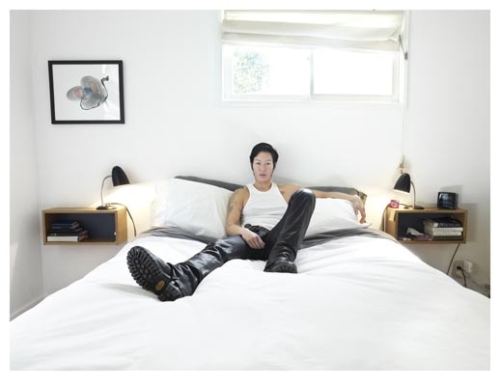 Finally, Rina Castelnuovo at Andrea Meislin, documentary photos along the Palestine-Israel divide. Castelnuovo gives both sides full human weight, although the image of an Orthodox Jewish man casually throwing his drink at a cowering Palestinian woman whose only crime is to try to pass him on the street, upends the show. He is so casual in his contempt, and she is so afraid.
Finally, Rina Castelnuovo at Andrea Meislin, documentary photos along the Palestine-Israel divide. Castelnuovo gives both sides full human weight, although the image of an Orthodox Jewish man casually throwing his drink at a cowering Palestinian woman whose only crime is to try to pass him on the street, upends the show. He is so casual in his contempt, and she is so afraid.
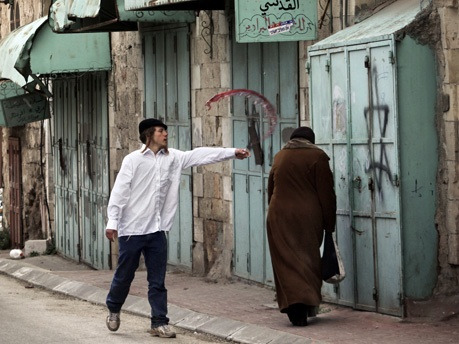



Interesting look into Arneson and the LA emi/immigrations.
Great work by Rina Castelnuovo. If you’re interested in that, check out Rajiv Kapoor – http://www.rajivkapoorphoto.com/ – he’s having a show at Vashion and Kinsey Galleries at Seattle U in the fall sometime. Solid work in a tricky genre.